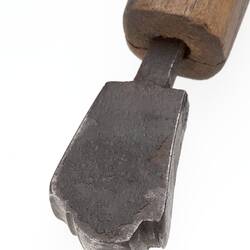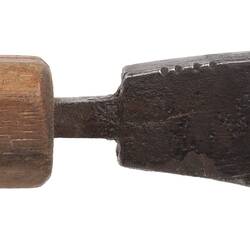Summary
This wooden-handled edge iron is part of Stanio Fancoff's extensive shoemaking kit. The edge iron family is the largest in the shoemaker's kit and each tool comes within various sizes and formats. Used heated, the edge iron is run under pressure along the shoe's sole edge to seal the leather from water, enhance its sturdiness and provide an aesthetic appearance of shine and fashionable style. This particular tool has on one side an elaborately curved edge, with a stepped style version on the other which allowed for greater diversity within shoe construction. This edge iron was an integral part of Stanio's shoemaking kit, that enhanced both the shoes function and its aesthetic qualities.
Stanio Ivanoff Fancoff was born in 1908 in Bojentsi, a small village in Bulgaria. At age 11, Stanio left home to learn the shoemaking trade. In 1929, he immigrated to Melbourne, settled in Fitzroy and began to work for the V.G. Zemancheff & Sons basket shoe factory in South Melbourne. In1936, he married Dorotea Georgi Touzou who had recently arrived in Australia. Around this time, Stanio set up his own shoemaking business from home, with Georgi, her cousin and sister weaving the shoes which he then assembled. Select shoe samples were then taken to Sydney and Tasmania for sale. In 1942, Georgi and Stanio moved to Broken Hill for Georgi's health; there daughter Nancy was born and Stanio set up a shoe shop/factory. In 1945, Georgi died and by 1950 Stanio and Nancy had moved to Adelaide where he again opened a shoemaking business and shop. He passed away in 1978, having been in the shoemaking business for 59 years. This collection documents his migration and working life experiences.
Physical Description
A glazing iron tool mounted onto a wooden handle. The medium brown wooden handle has been rounded to produce an octagonal shape. It has a small tan coloured leather tab singularly tacked to the handle's lower portion and a crack appears from the iron tool connection to approximately half way down the handle. The iron head tool appears on one side in a cut-down format and the flat section has four grooves, whilst on the other side, it is stepped shape. The metal surface is dark coloured, possibly resulting from past use processes.
Significance
This collection is significant in documenting a small migrant business as well as the fashion of a particular period. It is well provenanced and charts the application of trade skills in a new country. It also illustrates the stages of hand shoe manufacture from the 1930s, demonstrating the enduring nature of the tools and patterns that were used.
More Information
-
Collecting Areas
-
Acquisition Information
Donation from Nancy Vasileff, 21 Mar 2007
-
Past Owner or User
-
Classification
-
Category
-
Discipline
-
Type of item
-
Overall Dimensions
160 mm (Length), 25 mm (Width), 20 mm (Depth)
-
References
R.A. Salaman, 'Dictionary of Leather-working Tools c.1700-1950 and Tools of Allied Trades,' London: George Allen and Unwin (Publishers) Ltd, 1986 [Section 2: Boot and Shoe Maker pp18-185]. John Peacock. 'Shoes, The Complete Sourcebook,' London:Thames & Hudson Ltd, 2005. NAA holds file (online) on Vasil George Zemancheff, Fancoff's employer
-
Keywords
Boot & Shoemaking, Bulgarian Communities, Bulgarian Immigration, Immigration, Small Businesses, Tools




